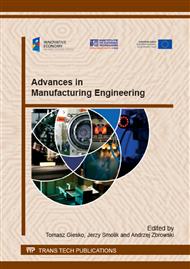[1]
W.J. Dixon, The Up-and-Down Method for Small Samples, Journal of the American Statistical Association. Vol. 60, No. 312 (1965), p.967–978.
DOI: 10.1080/01621459.1965.10480843
Google Scholar
[2]
W.J. Dixon, A.M. Mood, A Method for Obtaining and Analyzing Sensitivity Data, Journal of the American Statistical Association. Vol. 43, No. 241 (1948), p.109–126.
DOI: 10.1080/01621459.1948.10483254
Google Scholar
[3]
K.A. Brownlee et al., The Up-and-Down Method with Small Samples, Journal of the American Statistical Association. Vol. 48, No. 262 (1953), p.262–277.
DOI: 10.1080/01621459.1953.10483472
Google Scholar
[4]
H. Nakazawa, K. Shotaro, Statistical S-N Testing Method with 14 Specimens: JSME Standard Method for Determination of S-N Curves. Statistical Research on Fatigue and Fracture. Japan Society of Materials Science, Elsevier, New York, (1987).
Google Scholar
[5]
J.A. Collins, Failure of materials in mechanical design - analysis, prediction, prevention. John Wiley & Sons, New York, (1993).
Google Scholar
[6]
J. Zhang, D.B. Kececioglu, New approaches to determine the endurance strength distribution. 4th ISSAT International Conference on Reliability & Quality in Design , Seattle, (1998).
Google Scholar
[7]
D. Radaj, Design and Analysis of Fatigue Resistant Welded Structures. Woodhead Publishing Ltd., (1990).
Google Scholar
[8]
R. Litwinko, W. Oliferuk, Yield Point Determination Based On Thermomechanical Behaviour Of Polycrystalline Material Under Uniaxial Loading, Acta Mechanica et Automatica, Vol. 3, No. 4 (2009), pp.49-51.
Google Scholar
[9]
A. Lipski, The use of passive infrared thermography for tests of materials and riveted joints used in aviation industry- selected problems. Part II of the collection of monographs (edited by J. Szala): Experimental methods in studies of materials and riveted joints used in aviation industry - selected problems. Institute For Sustainable Technologies – National Research Institute in Radom, Bydgoszcz-Radom, 2010 (in Polish).
Google Scholar
[10]
A. Lipski, Impact Of The Strain Rate During Tension Test On 46Cr1 Steel Temperature Change, Key Engineering Materials, Vol. 598 (2014), pp.133-140.
DOI: 10.4028/www.scientific.net/kem.598.133
Google Scholar
[11]
M. Poncelet et al., Probabilistic multiscale models and measurements of self-heating under multiaxial high cycle fatigue, Journal of Mechanics and Physics of Solids, Vol. 58, No. 4 (2010), p.578–593.
DOI: 10.1016/j.jmps.2010.01.003
Google Scholar
[12]
C. Doudard et al., Determination of an HCF criterion by thermal measurements under biaxial cyclic loading, International Journal of Fatigue, Vol. 29, No. 4 (2007), p.748–757.
DOI: 10.1016/j.ijfatigue.2006.06.009
Google Scholar
[13]
A. Lipski, D. Skibicki, Variations Of The Specimen Temperature Depending On The Pattern Of The Multiaxial Load - Preliminary Research, Materials Science Forum, Vol. 726 (2012), pp.162-168.
DOI: 10.4028/www.scientific.net/msf.726.162
Google Scholar
[14]
D. Skibicki, J. Sempruch, A. Lipski, Ł. Pejkowski, Fatigue Life, Fractographic and Thermographic Analysis of Steel X2CrNiMo17-12-2 for Proportional and Non-Proportional Loads, The Tenth International Conference on Multiaxial Fatigue & Fracture, Kyoto (Japan), (2013).
DOI: 10.4028/www.scientific.net/msf.726.171
Google Scholar
[15]
A. Lipski, D. Boroński, Use of Thermography for the Analysis of Strength Properties of Mini-Specimens, Materials Science Forum, Vol. 726 (2012), pp.156-161.
DOI: 10.4028/www.scientific.net/msf.726.156
Google Scholar
[16]
G. La Rosa, A. Risitano, Thermographic methodology for rapid determination of the fatigue limit of materials and mechanical components, International Journal of Fatigue, Vol. 22, No. 1 (2000), p.65–73.
DOI: 10.1016/s0142-1123(99)00088-2
Google Scholar
[17]
G. Meneghetti, Analysis of the fatigue strength of a stainless steel based on the energy dissipation, International Journal of Fatigue, Vol. 29, No. 1 (2007), pp.81-94.
DOI: 10.1016/j.ijfatigue.2006.02.043
Google Scholar
[18]
M.P. Luong, Fatigue limit evaluation of metals using an infrared thermographic technique, Mechanics of Materials, Vol. 28, No. 1 (1998), p.155–163.
DOI: 10.1016/s0167-6636(97)00047-1
Google Scholar
[19]
F. Cura, G. Curti, R. Sesana, A new iteration method for the thermographic determination of fatigue limit in steels, International Journal of Fatigue, Vol. 27, No. 4 (2005), p.453–459.
DOI: 10.1016/j.ijfatigue.2003.12.009
Google Scholar
[20]
X.G. Wang, V. Crupi, X.L. Guo, Y.G. Zhao, Quantitative Thermographic Methodology for fatigue assessment and stress measurement, International Journal of Fatigue, Vol. 32, No. 12 (2010), p.1970–(1976).
DOI: 10.1016/j.ijfatigue.2010.07.004
Google Scholar
[21]
G. Fargione et al., Rapid determination of the fatigue curve by the thermographic method, International Journal of Fatigue, Vol. 24, No. 1 (2002), p.11–19.
DOI: 10.1016/s0142-1123(01)00107-4
Google Scholar


